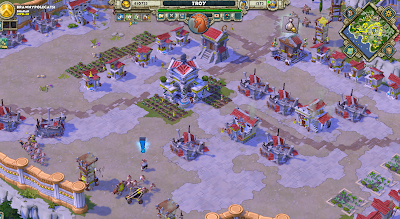 |
| Greek coat of arms used in AoEO |
This is the first of a series of articles in which I go through each of the six civs.
Many begin their AoEO experience with the Greeks, and I’m no different in this regard. The Greeks were my first civ, the ones I first took to level 40, the ones I first managed to gear right up to the rafters, the ones with which I first completed alliance and legendary quests, and they remain my one true love.
It’s probably natural that you might come to favour your first civ, primarily because you will become so familiar with it, get used to the bits and pieces you like most, get used to the various build orders, how to make your economy hum each and every quest, build a massive army, etc, etc.
So what do I like the most about the Greeks?
Click Open the book below to find out!
So what do I like the most about the Greeks?
Click Open the book below to find out!
- Siege; and
- Gastraphetes.
 |
| The Greek ballista |
You only need five or six upgraded ballistas to demolish most things thrown at you in AoEO (as a general rule, there are exceptions of course). They come into their own in reaching fixed targets over distance, in particular, the Cyprus quests which ask you to destroy enemy forts, or getting rid of the troublesome catapults which sometimes lurk at distance and wreak havoc on your army.
The ballista trireme are invaluable for the various water quests in Argos and Cyprus, especially where targets lie far inland.
But they both share a weakness – they do not like combat at close quarters.
With the ballista, you want your destructive babies sitting behind either a wall or what we commonly call a meat shield when roving the countryside, something to keep the enemy at arms length, to stop them reducing your prized weapons to kindling.
In the case of your ballista triremes, as a general rule, you will want to get your fireships out nice and early, mop up enemy ships, destroy their docks, repel all attempts to rebuild, and then unleash a long distance barrage from your big ships unimpeded. Soften the enemy up for a landing. In many cases, you can almost eliminate your enemy without the need to land at all. Now that’s firepower!
The gastraphetes can almost be viewed as a smaller version of the ballista, especially when massed (30+). The benefit they bring when mixed with your ballistas is that they can hit a moving target. As the opposing army comes towards you, if you have a mix of gastras and ballistas, they can act as a virtual meat shield while mowing the enemy down before they get to you (but if they come in sufficient numbers, especially with cavalry, they will reach your front line troops, and casualties will be inevitable).
 |
| Greek gastraphete |
The Greek civ comes with an Academy which provides military improvements, and one of the most potent is Greek fire (available in Age IV), which will improve the damage of both the gastras’ arrows as well as arrows from guard towers, forts and the town centre.
On top of the increased damage, seeing streams of lit arrows flying at the enemy, especially en masse, sends a surge of pride through you, it’s wonderful to behold. The moans and groans of the enemy being struck down is a constant reminder of a job well done.
On top of the siege and gastras, the Greek military capability is quite balanced and well rounded, with a good range of infantry and cavalry, as well as priests.
On the downside, some of the build times and unit creation times are a bit slower than the other civs, and the very best stuff is not available until Age IV, which can be an issue in PvP and various quests which can put you in two minds as to whether you should go for one final age up, or whether you should struggle on with whatever is available to you in Age III.
 |
| My hippikons and hetaroi gather for the coming battle with the elite rogues. |
 |
| Troy - a region in your Greek civ with a good series of quests |
 |
| This is a list of the Greek military units, and which other unit they best counter. |
Click here for part two of the Civilisations series - Egypt.
Click here for part three of the Civilisations series - Persians.


No comments:
Post a Comment